Menu
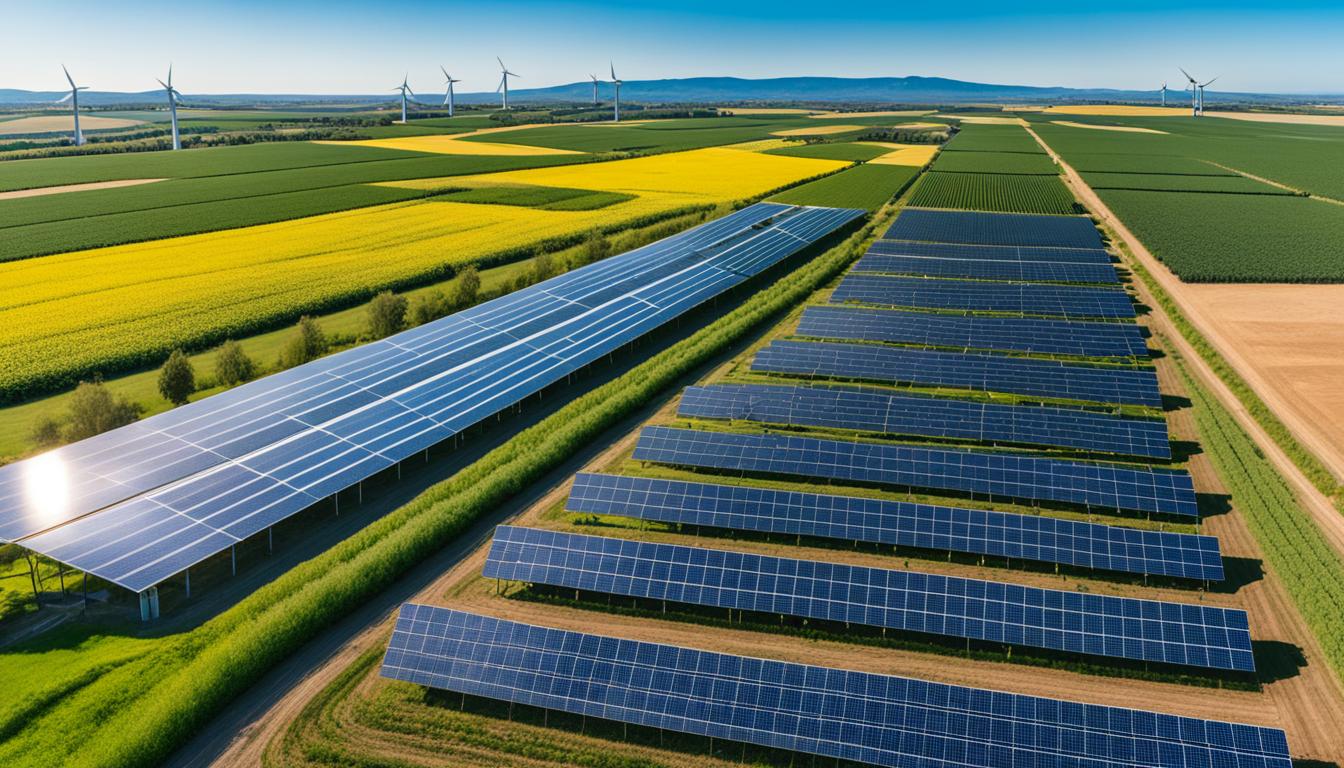
Did you know that food production and processing use up a third of the world’s energy? This big number shows us how much we could help the planet by greening up farming. By moving away from fossil fuels and turning to things like the sun and wind, we could make a big difference. We could cut down on harmful gas emissions, make farming more sustainable, and look after the environment.
Using sustainable energy on farms is key to using less fossil fuels. Things like solar panels, wind turbines, and using plant waste for energy can drop the energy bill by a lot. Plus, it makes farms tougher against changes in the environment. Solar power, for example, is cheap to run and is very green. Wind power keeps making power without stop and can even make money by selling excess electricity. Biomass, made from farm waste, helps farms by keeping things tidy and efficient.
These new energy sources not only help the environment but also save farms money and create new earning chances. With less spent on energy and becoming more sustainable, farms can stay strong in the long run. Choosing to go green like this is a big step towards making sure farming keeps on in a way that’s good for the planet.
Switching to sustainable energy in farming is key to tackle urgent environmental issues. It also helps farms work better. By using energy-friendly methods, we lower harmful emissions. This reduces our need for resources that don’t renew.
Fields that grow sustainable fuels, like biodiesel from camelina, canola, and sunflowers, are a great example. They turn crops into money and eco-friendly power. Take Roger Rainville, for example. He makes biodiesel at less than $2 a gallon. This saves on fuel and feeds his livestock.
The U.S. Department of Energy says wind power is growing fast. Wind turbines can make electricity on less than half an acre. They lower the cost of running a farm. In places with lots of wind, farmers can earn thousands per turbine each year.
Solar energy is also big in farming. Solar farms can grow crops all year, even tropical fruits in winter. They cut farmers’ power bills a lot. There are grants and programs helping farms buy these solar systems, which cuts the start-up costs.
Farms need to look into these renewable energy options for a sustainable future. Using green energy helps the planet and their wallet. It lets them stay in business and do good for the environment.
Solar power can change how farms work by meeting energy needs in a better way. It’s key for making farms that are kind to the environment. It’s all about aiming for a future where farming doesn’t harm the planet.
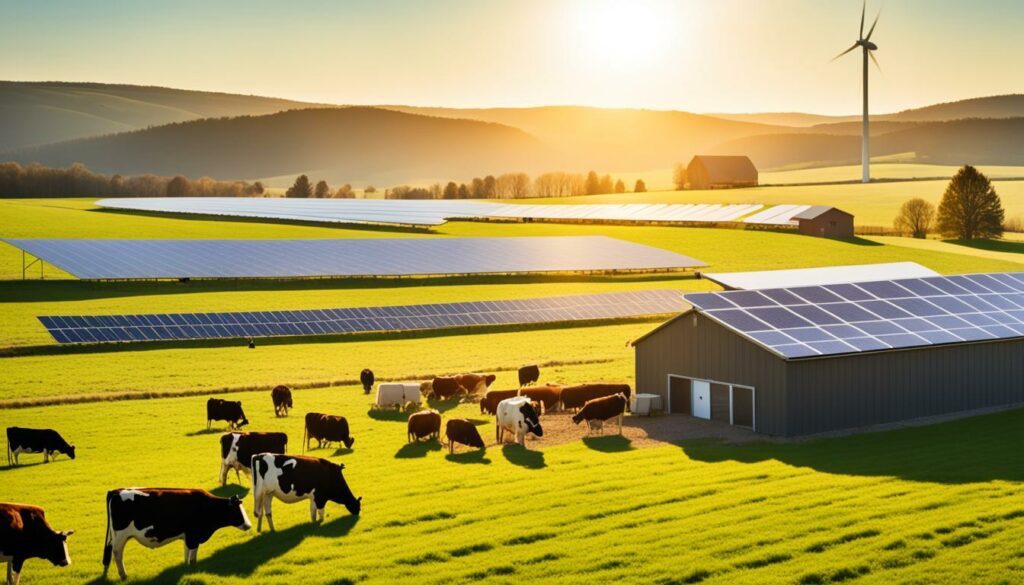
Solar power is great because it uses the sun’s free energy. This means it’s cheaper to run than many other ways of getting power. Farmers in the US are using solar power to heat water and their buildings. It works well for farms of all sizes and helps lower the cost of electricity by selling extra power back to the grid.
Solar power is good for the planet. It uses less water and causes less pollution. This is what climate-friendly farms want. It also makes farms more independent and can bring in money in the long run.
Yet, solar power also faces some problems. It can be hard when the sun isn’t shining, which means you need to find ways to store power for later. This is important to always have power when you need it. Planning and connecting to the grid well can help with this.
The cost to start using solar power can be a lot of money, which is hard for some farmers. Figuring out where to put the solar panels can also be tricky. Using up a lot of land for solar power means less space for farming or building houses.
But, even with these challenges, solar power is a great way to make farms better for the environment. It just needs smart planning and investment. This way, it supports both the environment and the economy of farms.
The benefits and challenges of solar power are further illustrated below:
| Aspect | Details |
|---|---|
| Cost Savings | Solar power systems can lead to reduced electricity bills, with farmers like Raymond Luhrman improving energy efficiency and profitability. |
| Environmental Impact | Solar energy reduces greenhouse gas emissions and uses little water, making it good for the environment. |
| Income Generation | On-farm solar installations can provide a secondary source of income through surplus energy sales. |
| Initial Cost | High upfront installation costs remain a barrier to entry for many farmers. |
| Space Requirements | Finding suitable land for solar panels can be challenging, with competition from agriculture and housing. |
So, knowing the good and hard parts of using solar power is important. It shows how much it can help in creating farms that are good for the climate and don’t harm the planet.
Wind energy is becoming a top choice for green farms, especially with more farms using wind turbines. If a farm is in a windy area, it can make good use of these power stations. As tech gets better, these turbines are more efficient at turning wind into power.
Farmers get help from the government to use wind energy. For example, in the U.S., there’s financial aid through the Production Tax Credit (PTC). In France, tax breaks are given to make wind turbines more attractive. These steps push more farmers to consider wind energy for their lands.
Vertical-axis wind turbines are getting popular on farms. They work well even at lower wind speeds and are not as tall. This means they don’t stick out as much and don’t disturb the environment too much. Companies in Europe are working on making wind turbines even quieter and safer for wildlife.
Support doesn’t just come from the federal level. Many states in the U.S., and Europe too, offer their own programs to help farmers. These can cover most of the costs of setting up wind energy. With this help, more farmers can go green and reduce their impact on the planet.
Wind energy is also a good way for farmers to earn money. In France, for example, a farmer can make €5,000 a year from each wind turbine. And in the U.S., the wind industry is a big part of the economy. In 2022, it brought in $20 billion and powered more than 10% of the country.
“Wind energy helps the U.S. avoid 336 million metric tons of carbon dioxide emissions annually, equivalent to the emissions from 73 million cars.”
By cutting down on greenhouse gases, wind energy plays a vital part in making farms greener. With turbines in every state, the U.S. shows the promise of wind power. There’s also a lot of work going into making sure wind farms and wildlife can live together. This shows that we can have both clean energy and protect nature.
Using biomass and bioenergy is key to boosting eco-friendly energy. These methods cut down on fossil fuel use. They also lower harmful gas emissions. Now, let’s look closer at how biomass power works.
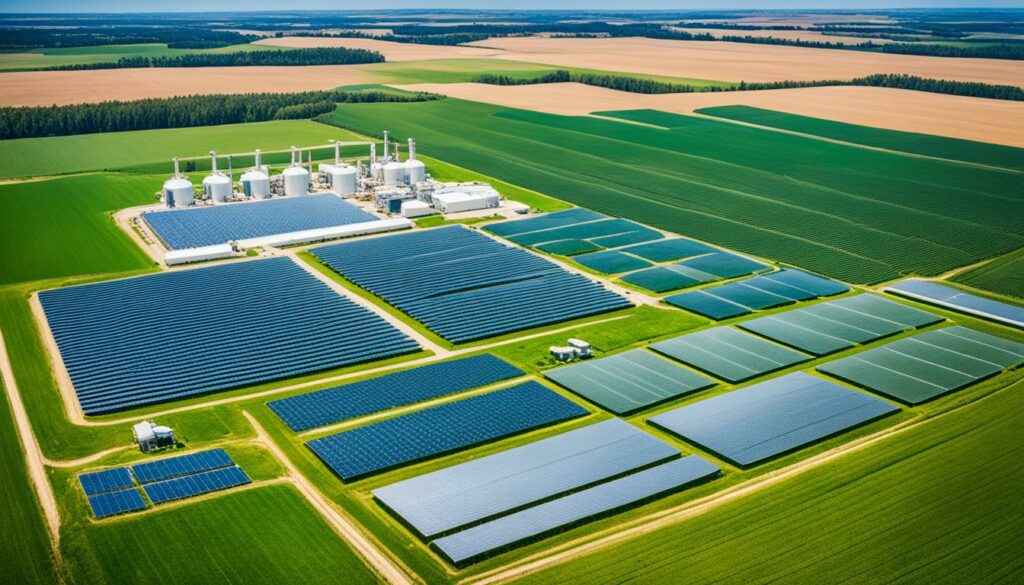
Biomass comes from many sources. This includes grains, food scraps, trees, and more. Even animal leftovers and city trash can be used. Such variety means we’ll always have what we need to make energy.
For example, leftovers from crops cover more than half of all agricultural waste. This shows we have plenty of stuff for making green energy.
There are some big wins with bioenergy:
These benefits show how bioenergy can make our farms greener. It’s all about using smart energy solutions to help the planet.
But, there are some hurdles:
Solving these problems takes smart steps. We need to carefully bring biomass into our energy plans. And we must consider the impact at every step.
Small-scale hydropower systems are great for farms near water. They use flowing water to produce energy. These systems can make up to 100 kilowatts of power. This is perfect for farms or homes that need green energy.
The special turbines in these systems work very well. Impulse turbines like Pelton and Turgo wheels are super efficient. They can change almost all the water’s energy into power. This makes them great for these small farms. But old-style waterwheels are not so useful. They are slow and big, so they’re not good for making electricity.
To figure out how much power a hydropower system can make, use the formula: Watts = Head (in feet) x Flow (in gpm) / 12. ‘Head’ means the height, and flow is how fast the water moves, measured in gallons per minute. You need at least 10 feet of height and 10 gallons per minute. For instance, 100 feet high with 10 gallons per minute creates about 83 watts.
Hydro systems last a long time and are cheap to run. But, you need to be close to enough water. There can be effects on wildlife and you have to follow laws closely. Starting costs are also high. However, these systems are very good for the environment. They help farms be greener and save money.
Geothermal energy is a big part of green energy. It uses the Earth’s stable temperatures to keep farms warm or cool. This makes it good for the planet by cutting down on harmful gases.
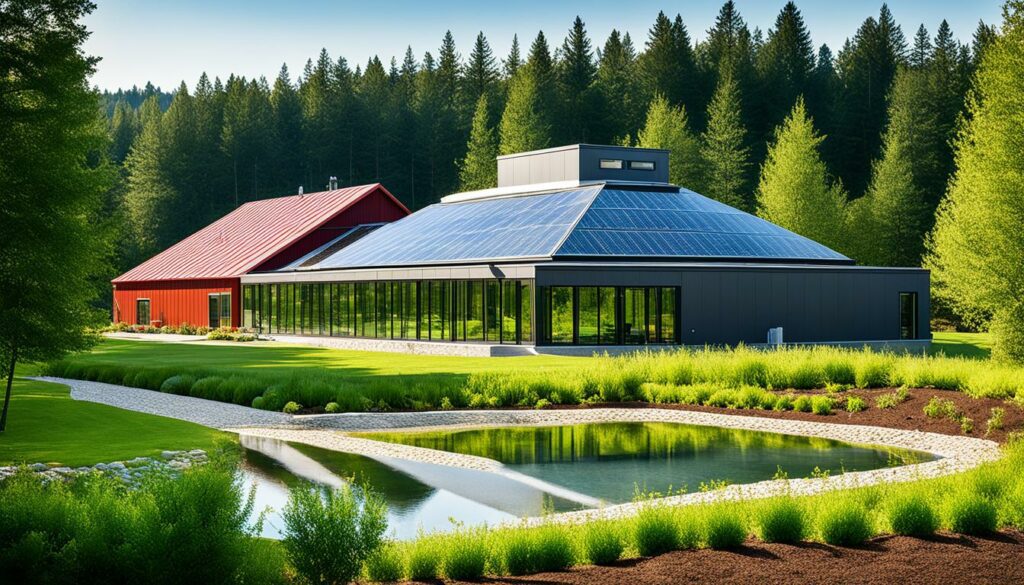
Geothermal systems work by harnessing the Earth’s natural heat. They use a series of pipes and a pump to move heat in and out of buildings. This method is effective, saving energy and being kind to the environment.
Geothermal systems have huge benefits for *sustainable energy farms*. They can lower a building’s energy use by 40-70%, cutting emissions too. Places like Boston University use geothermal, helping to fight climate change.
Even though they can cost more at first, their savings in the long run are worth it. Smith College’s geothermal project is saving them millions over 30 years. It helps reduce the farm’s bills and protects the environment.
Lastly, geothermal energy makes farms stronger and more reliable. It protects them from high and unpredictable energy costs. Epic Systems is one example where geothermal meets all their needs without relying on gas. This shows the key role geothermal plays in modern farming.
Implementing sustainable energy farms changes agriculture a lot. They use solar power, wind power, and other clean sources to protect the environment. This switch also helps them save money in the long run. Vermont’s Roger Rainville proves this by making biodiesel for less than $2 per gallon. This shows how much money can be saved and earned.
There are many green energy options for farms. Solar power can be used to warm water, buildings, and equipment, reducing the need for fossil fuels. Wind power is also popular and helps by providing energy for things like pumping water. It’s often used together with solar energy systems.
Farmers can also use biofuels and biofuel crops like camelina and canola. Biomass pellets made from plants like switchgrass are another option. They’re renewable and grow back quickly. These methods help produce energy without harming a lot of land. For instance, a wind turbine takes less space than half an acre, leaving most of the farm usable.
Using many types of energy makes farmers more independent and cuts down on fossil fuels. They can turn oil or fats into biodiesel or turn extra fruit into ethanol. These steps bring a new income too. Plus, there are money incentives that help these farms go even greener. This shows how important green energy is for our planet’s future.
In 2008, diesel prices hit $4-$5 per gallon, challenging Roger Rainville. He looked for ways to make fuel that was good for the Earth. So, he started a biodiesel production site at Borderview Farm. This move set a great example for making energy without harming the planet.
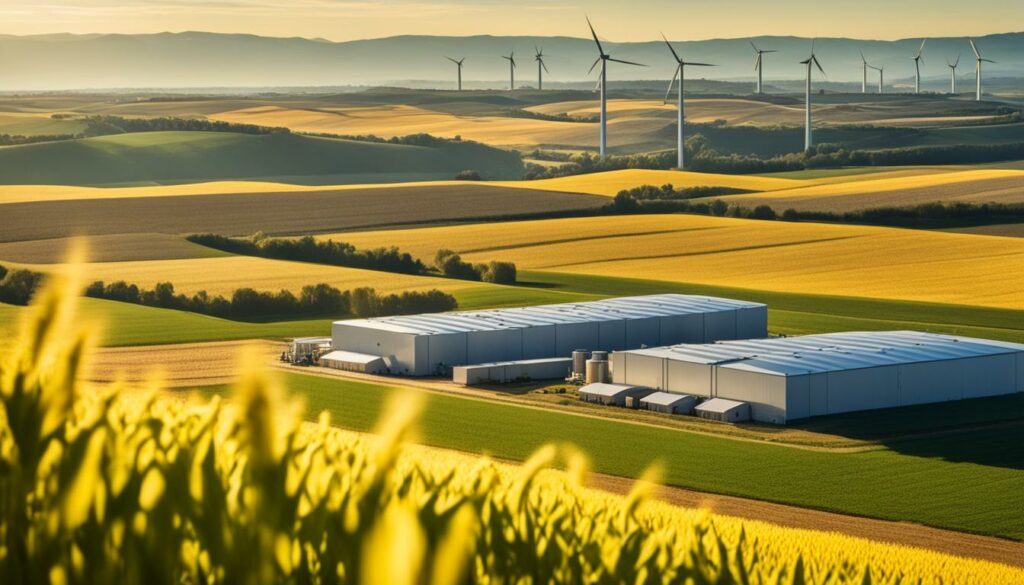
Rainville’s first step was to grow oilseed sunflowers. These plants are well-loved in Vermont for making oil. Each year, Borderview Farm processes 100 tons of sunflower seeds from 138 acres.
From this, they get 10,500 gallons of biodiesel. And there’s 64 tons of sunflower meal left. This meal is perfect for feeding livestock. The making process uses alcohol and a special chemical to turn the seeds into biodiesel efficiently.
Rainville uses between 500 and 3,000 gallons of biodiesel yearly. By using biodiesel, he spends much less on fuel. This means he saves between $500 and $4,000 every year. It shows how choosing sustainable fuels can save money and help the planet.
| Year | Biodiesel Savings |
|---|---|
| 2010 | $2,000 |
| 2012 | $3,500 |
| 2015 | $1,200 |
Rainville’s work is a top example of turning farms into places that produce clean energy. With these sustainable fuel fields, farms can make all the energy they need. Plus, they can earn more money. This is good for the environment and the farm’s wallet.
Adding eco-friendly renewable energy plants to farms is vital for the future. It’s key to know what energy the farm needs and what renewable resources are around. Globally, farming uses a lot of energy, which needs to change.
Farms need energy for many things like machinery and keeping crops watered. Relying on fossil fuels hurts the earth, so farms should look to renewable energy solutions in agriculture. This helps cut down on harmful gases.
Choosing solar panels or wind turbines depends on the farm’s location. Places with lots of sun can benefit from solar power, while windy areas suit wind energy. These are great for farms wanting to go green.
It’s important to plan carefully when adding eco-friendly renewable energy plants. Although the start-up costs might be high, you’ll save on energy in the long run. There are also incentives and tax breaks to help. Plus, farms can make money from extra power they produce.
Looking after these systems and following the rules is crucial. The aim is to meet safety and eco guidelines. These systems also offer power when the main grid is down.
Using renewable energy solutions in agriculture means being self-sufficient with power. It’s also good for the environment, which matters to the public and regulators. Farming sustainably helps both nature and the farm’s finances.
Boosting the use of renewable energy on farms is very important. This leads to farms using energy in a way that isn’t harmful to the climate. Financial support like incentives and grants help with the big costs at the start. These can make it easier for more farmers to use eco-friendly energy.
Things like tax breaks, discounts, and loans with low interest help a lot. They make it less of a money issue to put in renewable energy systems.
Grants from the government help a lot in starting with renewable energy. These can cover the costs of getting started and also make sure such projects can work in the long term.
| Incentive/Grant | Description | Benefit |
|---|---|---|
| Inflation Reduction Act | Helps finance eco-friendly energy projects | Makes the starting cost less |
| Renewable Energy Deployment Grant | Supports setting up green energy systems | Promotes using renewable energy |
| California Solar Initiative (CSI) | Provides cashbacks for solar panel setups | Cuts the cost of starting up |
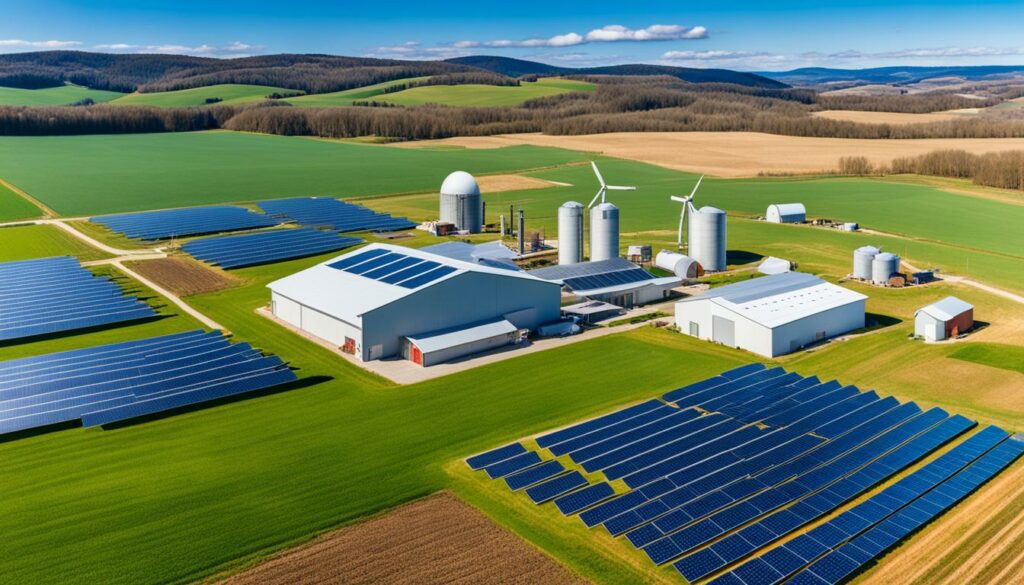
California is very keen on getting its power from eco-friendly sources. It’s aiming to stop adding to the climate problem by 2045. Already, in 2021, more than half of its power comes from green or no-carbon sources. This state offers a lot of help to its farmers so they can join the effort. This makes for a future where farming is good for the earth and makes sense money-wise.
By taking up these chances, farmers can make their own energy decisions. They also help the world on the path to cleaner energy. Thanks to this financial backing, we’re changing agriculture for the better. It’s a step towards a world that’s more eco-friendly and sustainable for our children.
Exploring new tech in sustainable energy shows big changes in farms. Adding high-tech sensors helps manage resources better. They give real-time info on water and energy use. This helps farms use resources wisely and makes their work more efficient.
IoT, or the Internet of Things, is also changing farming. It makes everything connected and smart. For example, it can control water used for plants. This means less water waste and healthier crops.
Next, we have machine learning and AI. These smart tools predict and manage energy needs well. They make sure everything runs smoothly, cutting down on problems. This means less time is wasted and farmlands work better.
Then, there are solutions for storing energy. These help when the sun or wind aren’t around. With new batteries and storing methods, farms can keep going without traditional energy sources. This lessens the need for the usual power grid.
All these new energy technologies are changing how farms work, for the better. By using these, farms become stronger and kinder to the planet. This is vital for their future success and the world we live in.
Switching to green energy in farming comes with big challenges, mainly due to the high costs at the start. The costs for things like solar panels and wind turbines are dropping, showing progress. But, the big first investment is still a lot. Many farmers find this daunting. They need to plan their finances well. Sometimes, they need help from the government to pay for these.
Farming needs a lot of money to start using renewable energy. Even though global spending on solar power was almost US$500 billion in 2022, many farms still find it hard to start due to the high initial costs. They have to carefully consider the long-term benefits. Financial support or grants are often needed to get started.
Getting into green energy also requires special technical skills. For example, solar and wind power can be off and on, making it necessary to have advanced energy storage and smart grid systems. It can be hard because not everyone in farming knows how to set up and maintain these systems.
There are also a lot of rules and policies that differ, and these can be a problem. The local environment can affect how easy it is to use energy from sources like water and the earth’s heat. Working out all the permits and adjusting to various rules can be tough. It needs farmers and the government to work together to solve these issues.
To move to cleaner energy use in farming, these hurdles need solving. Through good policies, teaching, and smart planning, the farming world can do a lot towards using greener and more sustainable energy.
It’s important to use sustainable energy on farms to cut down on fossil fuels and boost productivity. Such solutions also help keep ecosystems safe by lowering greenhouse gases and saving natural resources.
Sustainable energy matters in farming to produce power without hurting the planet. It means using fuels that are kind to the earth. This preserves the environment for the future and helps farms run better.
Solar power cuts electricity costs, can grow without big changes, and is cheap to run. It’s good for the planet, lowering harmful emissions and creating a climate-friendly farm.
Getting solar power on farms can be expensive at first, and it relies on the sun. Farms also need a lot of space in the right areas.
Wind power is affordable, uses endless wind, and might work all day. By being gentle on the environment, it’s a good fit for farms focused on sustainability and low impact.
Waste from farming and special crops are used for eco-friendly energy. They let farms make their own energy in a green way.
Bioenergy helps cut waste and use resources better. It’s great for green farms and clean energy plants.
The challenges are using enough biomass, land being used for food, the high cost at the start, and cleaning up how it’s used.
They provide reliable, clean power, cost less to run, and last a long time. Farms near water can use them, helping the planet and the farm.
Geothermal systems use the Earth’s stable temperatures for heating and cooling. They need special tools but save energy and lower emissions.
Geothermal energy is cheap to run, always there, and cuts down on fossil fuels. It’s a new way for farms to be green and make energy.
These farms are all about looking after the planet, saving money, and being prepared for the future. They show new, eco-friendly ways to farm.
Biodiesel starts from oilseed crops and uses alcohol plus a special mix to make the fuel. This shows how farms can be fuelled by plants, not harmful sources.
Making biodiesel on farms can save money and even bring in profit. It’s often cheaper than regular fuel, making farms more self-reliant and bringing in extra cash.
Bringing in renewable energy means looking at what energy is used, choosing the best tools, planning money, and keeping things working well. This makes farms greener and keeps them following the rules.
There are things like tax breaks, money back on spending, cheap loans, and grants for farm energy work. With these, making green energy on a farm makes more sense.
New tech like smart sensors, internet tools for managing resources, and clever systems, along with better ways to store energy. These all help make energy use more efficient and steady.
Starting with green power can be expensive and needs special skills. There are also a lot of rules and things to consider, like how much sun or wind a place gets. Good planning and help from laws are very important.